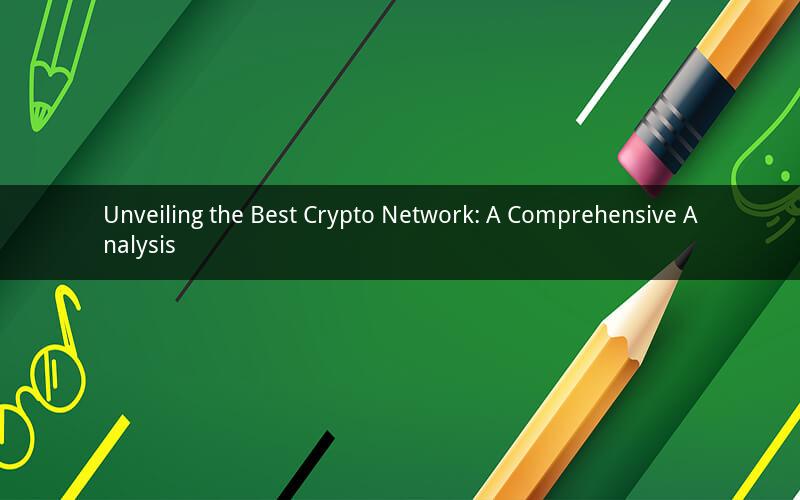
In the rapidly evolving world of cryptocurrencies, the question of which crypto network is the best often arises. With numerous options available, each offering unique features and capabilities, it can be challenging to determine the ideal choice for individuals and businesses alike. This article aims to delve into the key aspects of different crypto networks, helping readers make an informed decision about the best fit for their needs.
1. Bitcoin: The Pioneer of Crypto Networks
Bitcoin, launched in 2009, is often regarded as the pioneer of the crypto network. It introduced the concept of decentralized digital currency, allowing users to transfer funds securely without the need for intermediaries. Bitcoin's network operates on a proof-of-work consensus mechanism, requiring miners to solve complex mathematical puzzles to validate transactions. This process ensures the security and immutability of the blockchain.
Key Features:
- Decentralization: Bitcoin operates on a decentralized network, with no central authority controlling the currency.
- Security: The proof-of-work consensus mechanism ensures the security and immutability of the blockchain.
- Limited Supply: Bitcoin has a maximum supply of 21 million coins, making it a deflationary asset.
- Acceptance: Bitcoin is widely accepted as a payment method by numerous businesses and individuals.
2. Ethereum: The Platform for Smart Contracts
Ethereum, launched in 2015, stands out as the leading platform for smart contracts and decentralized applications (dApps). It introduced the concept of a programmable blockchain, allowing developers to build and deploy dApps without the need for a third party. Ethereum's network operates on a proof-of-stake consensus mechanism, making it more energy-efficient than Bitcoin.
Key Features:
- Smart Contracts: Ethereum enables the creation and execution of self-executing contracts, reducing the need for intermediaries.
- Decentralized Applications: Ethereum hosts a wide range of dApps, including decentralized finance (DeFi) platforms, gaming, and social media.
- Scalability: Ethereum is working on improving its scalability through layer 2 solutions, such as Optimism and Arbitrum.
- Decentralized Finance (DeFi): Ethereum has become the go-to platform for DeFi projects, offering various financial services without intermediaries.
3. Binance Smart Chain: The Fastest Growing Crypto Network
Binance Smart Chain (BSC) is a decentralized blockchain platform launched by Binance, the world's leading cryptocurrency exchange. BSC aims to provide a high-performance and low-cost solution for developers and users. It operates on a proof-of-stake consensus mechanism, making it energy-efficient and scalable.
Key Features:
- High Performance: BSC offers high throughput and low transaction fees, making it suitable for developers and users.
- Cross-Chain Interoperability: BSC supports cross-chain interoperability, allowing users to interact with other blockchains.
- Decentralized Finance (DeFi): BSC has become a popular platform for DeFi projects, offering a wide range of financial services.
- NFTs: BSC supports the creation and trading of non-fungible tokens (NFTs), making it a suitable platform for artists and creators.
4. Cardano: The Research-Driven Crypto Network
Cardano is a research-driven blockchain platform that aims to offer a more sustainable and scalable solution compared to other crypto networks. It operates on a proof-of-stake consensus mechanism, making it energy-efficient. Cardano's unique approach to blockchain development involves a layered architecture, with a separate layer for the settlement layer (where transactions are validated) and a separate layer for the computation layer (where smart contracts are executed).
Key Features:
- Layered Architecture: Cardano's unique layered architecture allows for better scalability and flexibility.
- Proof-of-Stake Consensus: Cardano's proof-of-stake mechanism ensures energy efficiency and lower transaction fees.
- Ouroboros Protocol: Cardano uses the Ouroboros protocol for consensus, which is known for its security and efficiency.
- Research-Driven Development: Cardano's development is based on extensive research, ensuring a robust and sustainable platform.
5. Polkadot: The Interoperability Solution
Polkadot is a decentralized protocol that aims to connect different blockchains, enabling them to share resources and information. It aims to solve the interoperability issues faced by the current crypto ecosystem. Polkadot operates on a proof-of-stake consensus mechanism, making it energy-efficient.
Key Features:
- Interoperability: Polkadot enables different blockchains to communicate and share resources, solving interoperability issues.
- Cross-Chain Transactions: Polkadot allows for cross-chain transactions, making it easier for users to interact with different blockchains.
- Decentralized Governance: Polkadot uses a decentralized governance model, allowing stakeholders to participate in decision-making.
- Scalability: Polkadot aims to provide a scalable solution for the growing number of blockchains in the ecosystem.
Related Questions:
1. What are the main differences between the Bitcoin and Ethereum networks?
2. How does the Binance Smart Chain compare to the Ethereum network in terms of performance and cost?
3. What makes Cardano's layered architecture different from other crypto networks?
4. Can you explain the concept of interoperability in the context of Polkadot?
5. How does the proof-of-stake consensus mechanism work, and what are its advantages over the proof-of-work mechanism?
In conclusion, determining the best crypto network depends on individual needs and preferences. Each network has its unique features and capabilities, making it essential to consider factors such as security, scalability, and use case when making a decision. With the continuous evolution of the crypto ecosystem, it is crucial to stay informed and adapt to the changing landscape.